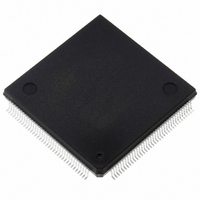ST10F276Z5Q3TR STMicroelectronics, ST10F276Z5Q3TR Datasheet - Page 202

ST10F276Z5Q3TR
Manufacturer Part Number
ST10F276Z5Q3TR
Description
MCU 16BIT 832KBIT FLASH 144-PQFP
Manufacturer
STMicroelectronics
Series
ST10r
Datasheet
1.ST10F276Z5T3.pdf
(239 pages)
Specifications of ST10F276Z5Q3TR
Core Processor
ST10
Core Size
16-Bit
Speed
64MHz
Connectivity
ASC, CAN, EBI/EMI, I²C, SSC, UART/USART
Peripherals
POR, PWM, WDT
Number Of I /o
111
Program Memory Size
832KB (832K x 8)
Program Memory Type
FLASH
Ram Size
68K x 8
Voltage - Supply (vcc/vdd)
4.5 V ~ 5.5 V
Data Converters
A/D 24x10b
Oscillator Type
Internal
Operating Temperature
-40°C ~ 125°C
Package / Case
144-QFP
Processor Series
ST10F27x
Core
ST10
Data Bus Width
16 bit
Data Ram Size
68 KB
Interface Type
CAN, I2C
Maximum Clock Frequency
64 MHz
Number Of Programmable I/os
111
Number Of Timers
5
Maximum Operating Temperature
+ 125 C
Mounting Style
SMD/SMT
Minimum Operating Temperature
- 40 C
On-chip Adc
10 bit, 24 Channel
For Use With
497-6399 - KIT DEV STARTER ST10F276Z5
Lead Free Status / RoHS Status
Lead free / RoHS Compliant
Eeprom Size
-
Lead Free Status / Rohs Status
Details
Available stocks
Company
Part Number
Manufacturer
Quantity
Price
Company:
Part Number:
ST10F276Z5Q3TR
Manufacturer:
STMicroelectronics
Quantity:
10 000
- Current page: 202 of 239
- Download datasheet (3Mb)
Electrical characteristics
202/239
periods within the considered time interval.
On the contrary, assuming again a noiseless PLL input and supposing that the VCO is
dominated by its 1/f
where N is the number of clock periods within the considered time interval.
The jitter in the PLL loop can be modelized as dominated by the i1/f
than a certain value depending on the PLL output frequency and on the bandwidth
characteristics of loop. Above this first value, the jitter becomes dominated by the i1/f
component. Lastly, for N greater than a second value of N, a saturation effect is evident, so
the jitter does not grow anymore when considering a longer time interval (jitter stable
increasing the number of clock periods N). The PLL loop acts as a high pass filter for any
noise in the loop, with cutoff frequency equal to the bandwidth of the PLL. The saturation
value corresponds to what has been called self referred long term jitter of the PLL. In
Figure 56
CPU frequencies) is shown: The curves represent the very worst case, computed taking into
account all corners of temperature, power supply and process variations; the real jitter is
always measured well below the given worst case values.
Noise in supply and substrate
Digital supply noise adds determining elements to PLL output jitter, independent of the
multiplication factor. Its effect is strongly reduced thanks to particular care used in the
physical implementation and integration of the PLL module inside the device. In any case,
the contribution of digital noise to global jitter is widely taken into account in the curves
provided in
Figure 53. ST10F276Z5 PLL jitter
the maximum jitter trend versus the number of clock periods N (for some typical
Figure
T
±5
±4
±3
±2
±1
JIT
0
0
56.
3
noise, the R.M.S. value of the accumulated jitter is proportional to N,
200
16 MHz
400
24 MHz
N (CPU clock periods)
600
32 MHz
40 MHz
800
1000
2
1200
noise for N smaller
64 MHz
1400
ST10F276Z5
3
noise
Related parts for ST10F276Z5Q3TR
Image
Part Number
Description
Manufacturer
Datasheet
Request
R

Part Number:
Description:
MCU 16BIT 832K FLASH 144-LQFP
Manufacturer:
STMicroelectronics
Datasheet:

Part Number:
Description:
MCU 16BIT 832K FLASH 144-LQFP
Manufacturer:
STMicroelectronics
Datasheet:

Part Number:
Description:
MCU 16BIT 832K FLASH 144-PQFP
Manufacturer:
STMicroelectronics
Datasheet:

Part Number:
Description:
MCU 16BIT 832K FLASH 144-PQFP
Manufacturer:
STMicroelectronics
Datasheet:

Part Number:
Description:
16-bit Microcontrollers - MCU 16-Bit MCU 832 kByte 68 KB RAM CMOS
Manufacturer:
STMicroelectronics

Part Number:
Description:
STMicroelectronics [RIPPLE-CARRY BINARY COUNTER/DIVIDERS]
Manufacturer:
STMicroelectronics
Datasheet:

Part Number:
Description:
STMicroelectronics [LIQUID-CRYSTAL DISPLAY DRIVERS]
Manufacturer:
STMicroelectronics
Datasheet:

Part Number:
Description:
BOARD EVAL FOR MEMS SENSORS
Manufacturer:
STMicroelectronics
Datasheet:

Part Number:
Description:
NPN TRANSISTOR POWER MODULE
Manufacturer:
STMicroelectronics
Datasheet:

Part Number:
Description:
TURBOSWITCH ULTRA-FAST HIGH VOLTAGE DIODE
Manufacturer:
STMicroelectronics
Datasheet:

Part Number:
Description:
Manufacturer:
STMicroelectronics
Datasheet:

Part Number:
Description:
DIODE / SCR MODULE
Manufacturer:
STMicroelectronics
Datasheet:











